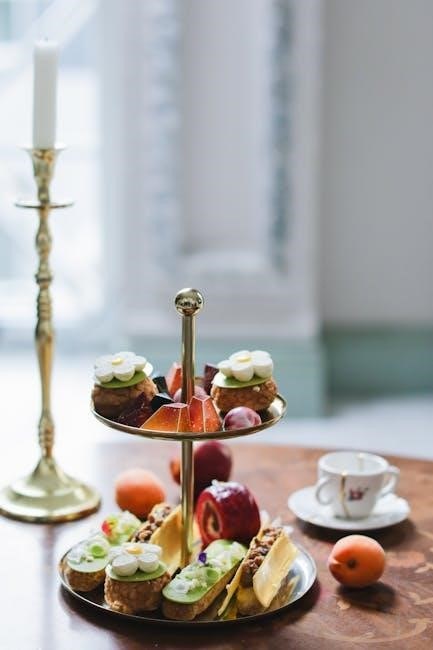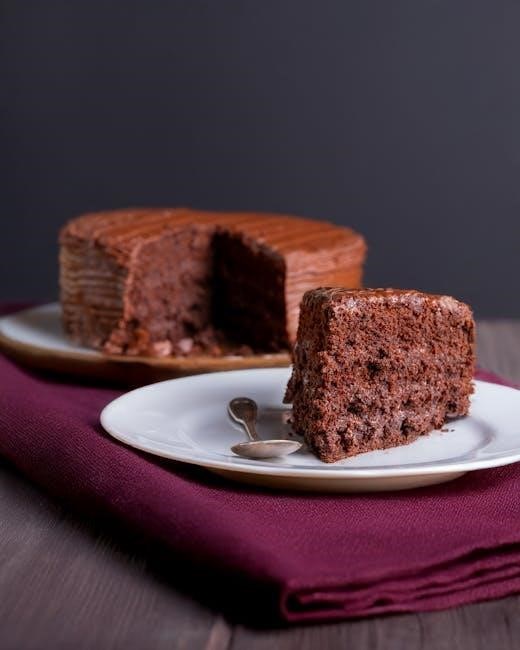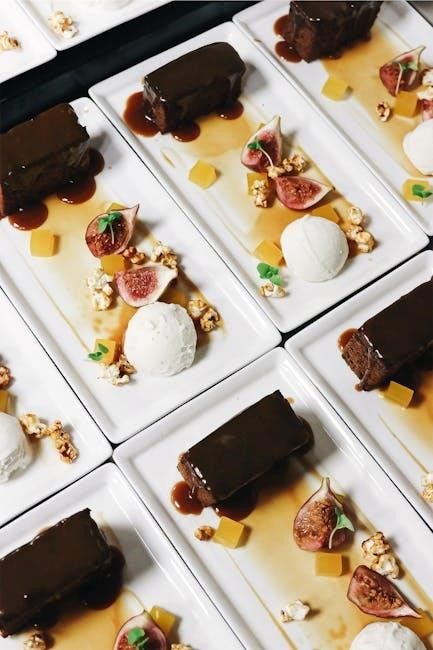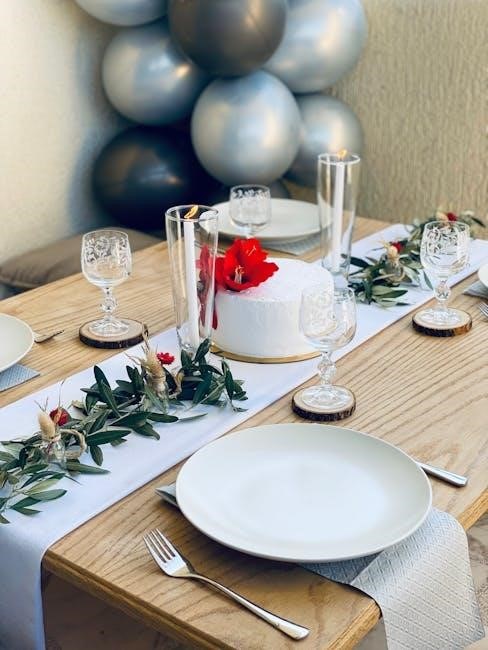Understanding cake serving sizes is crucial for planning events. This guide helps determine the right cake size based on occasion, guest count, and portion preferences, ensuring perfect portions every time.
Understanding the Importance of Proper Cake Portioning
Proper cake portioning ensures every guest enjoys an equal share, balancing satisfaction and resource management. Accurate serving sizes prevent waste and overconsumption, essential for events like weddings and parties. A standard slice, typically 1×2 inches, is ideal for weddings, while larger portions suit casual gatherings. Correct portioning also maintains the cake’s aesthetic appeal, as uneven slices can detract from its presentation. Understanding portioning helps in planning batter quantities and costs, making it a critical step in cake preparation. By aligning portion sizes with the occasion, hosts can create a memorable experience without excess. This guide provides insights to help you master portioning, ensuring your cake meets both visual and taste expectations for any event.
Overview of Standard Cake Serving Guidelines
Standard cake serving guidelines provide a framework for determining the number of slices based on size and occasion. A typical serving size is 1×2 inches for weddings and 1.5×2 inches for parties. Round cakes, such as 6-inch (serves 8-10) or 10-inch (serves 20-24), have specific guidelines, while sheet cakes offer larger capacities. Wedding portions are often smaller to ensure elegance, while party slices may be more generous. These standards help hosts plan accurately, avoiding waste or shortage. By adhering to these guidelines, you can ensure consistent portions, making your event more organized and enjoyable. Understanding these basics is key to selecting the right cake size for any gathering, ensuring everyone leaves satisfied.

Basic Cake Serving Sizes and Charts

Standard cake serving sizes vary by shape and occasion, with round cakes serving 8-12 slices, square cakes offering similar portions, and sheet cakes accommodating larger gatherings. Tiered cakes provide versatility, ensuring every event is perfectly portioned.
Round Cake Serving Guide
A round cake’s serving capacity varies by size and occasion. A 6-inch round cake typically serves 8-10 dessert portions or 16-20 coffee-sized slices. An 8-inch round cake serves 12-15 dessert portions or 24-28 coffee servings. A 10-inch round cake provides 20-24 dessert slices or 35-40 coffee portions, while a 12-inch round cake offers 28-32 dessert servings or 50-60 coffee servings. These sizes are ideal for small gatherings to large events, depending on the slice size. Understanding these guidelines ensures you can plan accurately for any occasion, whether it’s a party or a wedding. Knowing the serving capacity of round cakes helps in choosing the right size to meet your guests’ needs without excess or shortage.
Square Cake Serving Chart
Square Cake Serving Chart
A square cake’s serving size depends on its dimensions and the occasion. A 6-inch square cake typically serves 9-12 slices, while an 8-inch square cake serves 12-16 slices. For larger gatherings, a 10-inch square cake provides 24-28 servings, and a 12-inch square cake offers 35-40 servings. These measurements are based on standard party-sized portions, which are generally 1 inch wide and 2 inches deep; Square cakes are versatile and ideal for both casual and formal events. Understanding these serving charts helps in selecting the appropriate size to ensure every guest is accommodated with the perfect portion. This guide is essential for planning events where precise portion control is necessary, making it easier to choose the right square cake size for your needs.
Sheet Cake Serving Sizes
Sheet cakes are ideal for large gatherings due to their generous serving capacity. A standard sheet cake typically measures 9×13 inches and can serve between 48 to 96 guests, depending on portion sizes. For smaller events, a 9×13-inch sheet cake serves 12-15 people with larger slices or 24-30 with smaller ones. The serving size is usually 1×2 inches, making them perfect for weddings, parties, or corporate events. Understanding sheet cake serving sizes ensures you can accommodate your guest list without over- or underestimating. This flexibility makes sheet cakes a practical choice for event planners seeking efficient portion control and ease of serving. They are a versatile option for any occasion, offering both convenience and generous portions.
Factors Influencing Cake Serving Sizes
Portion sizes vary based on occasion, cake height, layers, and serving type. Dessert and coffee slices differ, with dessert being larger. Event type and guest appetite also impact serving sizes, ensuring the right balance for any celebration or gathering.
Occasion-Specific Serving Portions
Different events require varying serving sizes. For weddings, smaller slices of about 1×2 inches are traditional, allowing guests to enjoy a taste without excess. Parties often allow for larger portions, with slices measuring up to 1.5×3 inches. Dessert servings are typically bigger, around 3×1 inches, while coffee servings are smaller, at 1×1 inches. The choice of portion size depends on the event’s formality and guest preferences. For example, tiered cakes at weddings use smaller slices, while sheet cakes at casual gatherings may offer larger cuts. Understanding these distinctions helps in planning the perfect cake size for any occasion, ensuring satisfaction and avoiding waste.
Party vs. Wedding Cake Serving Sizes
Party and wedding cakes differ significantly in serving sizes. Party cakes typically offer larger slices, often 1.5×3 inches, catering to casual gatherings where guests may prefer heartier portions. In contrast, wedding cakes feature smaller slices, usually 1×2 inches, allowing for more servings and a delicate, elegant presentation. This smaller size also accommodates multi-tiered designs, where each tier may serve a specific number of guests. The distinction reflects the differing priorities of each event: parties focus on generosity, while weddings emphasize precision and aesthetics. Understanding these differences helps in selecting the appropriate cake size and portioning for each occasion, ensuring both guest satisfaction and visual appeal.

Impact of Cake Height and Layers
Cake height and layers significantly influence serving sizes. A standard 2-layer cake typically serves more than a single-layer cake due to increased volume. Each additional layer adds height, allowing for narrower slices while maintaining portion size. For example, a 2-layer cake might serve 12-15 people, while a 3-layer cake could serve 18-24. Tiered cakes, often used in weddings, amplify this effect, with each tier contributing to the total number of servings. The height of each layer also affects slice dimensions, as taller cakes can be cut into thinner slices without reducing the overall volume. This flexibility in layering and height makes it easier to customize cakes for events, ensuring ample portions while accommodating design preferences. Proper calculation of layers and height is essential for accurate serving size estimates.

Popular Cake Sizes and Servings
Cake sizes vary, with a 6-inch serving 12, 8-inch serving 24, 10-inch serving 36, and 12-inch serving 48 people, offering options for any event size or preference.
6-Inch Cake Serving Capacity
A 6-inch cake is ideal for small gatherings, serving 8-10 dessert portions or 16-20 coffee-sized slices. This size is perfect for intimate events, offering enough for a small group while maintaining a generous serving size. Dessert portions are typically 3×1 inches, while coffee servings are smaller at 1.5×1 inches. This versatility makes the 6-inch cake a popular choice for parties, celebrations, or even as a single-tier dessert. Its compact size ensures freshness and ease of serving, making it a favorite for hosts who want to provide a delicious treat without excess. Whether for a cozy dinner or a small party, the 6-inch cake delivers the perfect balance of flavor and portion control.
8-Inch Cake Serving Capacity
An 8-inch cake is a versatile option for medium-sized gatherings, serving 8-12 party slices or 12-16 wedding slices. Its size makes it ideal for events like birthdays or small celebrations. Dessert portions are typically 1×2 inches, while coffee servings are smaller at 1.5×1 inches. This cake size offers a balanced number of servings, ensuring everyone enjoys a generous slice without excess. It’s a popular choice for hosts who need to accommodate a modest guest list while maintaining a visually appealing presentation. The 8-inch cake strikes the perfect balance between portion size and overall yield, making it a practical and elegant option for various occasions.

10-Inch Cake Serving Capacity
A 10-inch cake is a popular choice for larger gatherings, offering 20-24 party servings or 24-28 wedding servings. Its generous size makes it ideal for events like anniversaries or larger birthday celebrations. Party slices are typically 1×2 inches, while wedding slices are slightly smaller, around 1×2 inches but more precisely measured. This size ensures ample portions without overwhelming guests. It’s a versatile option, suitable for both casual and formal events, providing a balanced yield of servings. The 10-inch cake is a practical choice for hosts needing to accommodate a larger guest list while maintaining a visually appealing and generously portioned dessert. Its capacity makes it a standout option for events requiring a substantial yet manageable cake size.
12-Inch Cake Serving Capacity
A 12-inch cake offers 35-40 dessert servings or 50-55 coffee servings, making it perfect for large events like weddings or corporate functions. Its substantial size ensures generous portions for a big crowd. Ideal for tiered setups, it provides enough slices for both dessert and coffee portions. This size is great for events requiring a grand centerpiece, offering flexibility in serving styles. The 12-inch cake is a reliable choice for hosts needing to accommodate a large number of guests with ample servings. Its capacity ensures every attendee can enjoy a slice, making it a practical and impressive option for significant celebrations. The 12-inch cake is a top choice for events demanding a large yet elegantly portioned dessert, ensuring satisfaction for all guests.

Specialty Cake Serving Guides
Specialty cakes, such as tiered or single-tier designs, require precise portioning. These guides help match cake sizes to events, ensuring every guest enjoys the perfect slice.
Tiered Cake Serving Sizes
Tiered cakes are designed to serve large groups, with each tier offering different portion sizes. A standard tiered cake serving is typically 1 inch by 2 inches, ideal for weddings and formal events. This size ensures guests can enjoy a slice without excess. For smaller gatherings, tiers can be adjusted, reducing the number of servings while maintaining elegance. The height and layers of each tier also impact the total number of servings, making it essential to plan according to guest count and portion preferences. By calculating each tier’s capacity, you can create a balanced and visually stunning cake that meets your event’s needs perfectly.
Single-Tier Cake Serving Chart
A single-tier cake is a popular choice for smaller gatherings, offering a straightforward serving solution. Typically, a 6-inch cake serves 8-10 dessert portions or 16-20 coffee-sized slices. An 8-inch cake can provide 12-16 dessert servings or 24-32 coffee servings. For larger events, a 10-inch cake yields 20-24 dessert servings or 40-48 coffee portions, while a 12-inch cake serves 35-40 dessert slices or 70-80 coffee servings. The serving size depends on the occasion, with dessert portions being larger (1×2 inches) and coffee portions smaller (1×1 inches). This chart helps planners choose the ideal cake size, ensuring there’s enough for everyone without excess. It’s a practical tool for events ranging from intimate celebrations to larger parties.

Serving Size Variations
Serving sizes vary based on occasion and preference. Dessert portions are typically 1×2 inches, while coffee servings are 1×1 inches, catering to different event needs effectively.
Dessert Serving Sizes

Dessert serving sizes are typically larger than coffee portions, averaging 1×2 inches per slice. A 6-inch cake yields 8-10 dessert servings, while a 12-inch cake serves 35-40. These portions are ideal for events where guests expect a satisfying treat. Standard dessert slices ensure consistency, making it easier to plan for gatherings. Whether it’s a party or a special occasion, these sizes provide a generous yet balanced serving, allowing everyone to enjoy without excess. This guide helps in selecting the right cake size to meet dessert needs, ensuring every guest leaves satisfied.
Coffee Serving Sizes
Coffee serving sizes are smaller, typically 1×1 inches per slice, making them ideal for lighter bites. A 6-inch cake offers 16-20 coffee servings, while a 12-inch cake provides 60-70. These portions are perfect for events like breakfast gatherings or afternoon meetings. Coffee-sized slices allow guests to enjoy a taste without overindulging. This guide helps in planning cakes for such settings, ensuring every slice aligns with the event’s tone. Whether it’s a corporate event or a casual meetup, coffee serving sizes offer convenience and flexibility, making them a popular choice for hosts seeking smaller, manageable portions.
Practical Tips for Cutting Cakes
Use a serrated knife for smooth cuts. Chill the cake to firm it, making slicing easier. Place on a turntable for even portioning and clean presentation.
How to Cut Even Cake Slices
To achieve even cake slices, start by chilling the cake to firm it, making it easier to cut cleanly. Place the cake on a flat surface or a turntable for better access. Use a serrated knife, as it glides smoothly through the layers without tearing. Begin by making a small notch at the top edge to guide your cuts. Slice in a gentle sawing motion, applying light pressure. For uniform portions, measure each slice using a ruler or a cake cutter with preset markings. After each cut, wipe the knife clean to prevent crumbs from accumulating and affecting the next slice’s appearance. This method ensures consistent serving sizes and a visually appealing presentation. Additionally, consider using a cake leveler to ensure the cake is even before slicing, which helps in achieving uniform thickness across all slices. For tiered cakes, cut from the bottom tier upwards to maintain stability. By following these steps, you can create perfectly even slices every time, impressing guests with both taste and presentation. Rounded cakes can be sliced by marking equal sections visually or using a cake wheel for precision. Remember, patience is key—taking your time ensures each slice is as perfect as the last. If serving a crowd, pre-slicing and arranging the cake on a serving platter can streamline the process. Overall, proper technique and the right tools make cutting even cake slices a breeze, whether for a casual gathering or a grand celebration. This approach not only satisfies appetites but also enhances the aesthetic appeal of your dessert spread, making it a delightful experience for everyone involved. Finally, don’t forget to serve with a smile, as presentation and portioning go hand in hand in creating memorable events. With practice, cutting even cake slices becomes second nature, allowing you to focus on other aspects of your event. So, next time you’re tasked with slicing a cake, remember these tips and enjoy the satisfaction of perfectly portioned treats; After all, a beautifully cut cake is the icing on the celebration cake—literally and figuratively. So, take your time, stay steady, and let your knife do the work. Happy baking and slicing!
Tools for Accurate Cake Portioning
Accurate cake portioning requires the right tools to ensure even and consistent slices. A serrated knife is essential for clean cuts, while a cake cutter with preset markings simplifies portioning. Use a ruler to measure slices precisely, especially for uniformity in large gatherings. A cake leveler ensures the cake is even before slicing, preventing uneven portions. For tiered cakes, a cake saw or long serrated knife helps cut through multiple layers smoothly. Turntables allow easy access to all sides of the cake, making slicing efficient. Serving platters or cake stands can help organize slices neatly. Additionally, portion guides or cake cutting templates provide visual markers for consistent sizing. Investing in these tools ensures professional-grade portioning, whether for a small party or a grand event, making your cake serving process both efficient and impressive. Proper tools enhance both the presentation and portioning accuracy, ensuring every guest enjoys a perfectly sized slice. By using these tools, you can achieve uniformity and precision, making your cake serving experience seamless and enjoyable for everyone involved. Moreover, these tools are versatile, catering to different cake shapes and sizes, from round to square and tiered designs. With the right equipment, you can confidently serve cakes that meet your guests’ expectations, whether it’s a dessert or coffee portion size. This approach not only saves time but also elevates the professionalism of your cake presentation, making it a standout feature of your event. Finally, remember that the quality of your tools directly impacts the quality of your cake portions, so choosing durable and reliable options is key to achieving consistent results. With these tools in hand, you’ll be well-prepared to handle any cake-serving situation with ease and precision. So, next time you’re preparing a cake, make sure to have these essential tools on hand to ensure accurate and impressive portioning. After all, the right tools make all the difference in delivering a perfectly portioned cake that everyone will appreciate.
Mastering cake serving sizes ensures memorable events. Proper planning, portioning, and presentation make every celebration sweeter. Use these insights to create perfectly sized slices for any occasion.
Final Thoughts on Cake Serving Sizes
Proper cake serving sizes are essential for ensuring satisfaction at any event. Whether it’s a wedding or a party, understanding portion guidelines helps in avoiding waste and overindulgence. Always consider the occasion and guest preferences when selecting cake sizes. A 6-inch cake serves 12 people, while a 12-inch serves up to 60, depending on slice sizes. Use charts to plan effectively, and remember, smaller slices like 1×2 inches are ideal for weddings, while larger portions suit parties. With the right tools and techniques, you can achieve even cuts and perfect portions, making your event unforgettable. Planning ahead ensures everyone enjoys their slice.
Key Takeaways for Perfect Portioning
For perfect cake portioning, consider the occasion and guest count. Use size charts to determine servings, with round cakes ranging from 6-12 inches and square or sheet cakes offering varied capacities. Plan for smaller slices at weddings (1×2 inches) and larger ones at parties. Remember, a 6-inch cake serves 12, while a 12-inch serves up to 60, depending on slice size. Tools like cake slicers ensure even cuts, while tiered cakes offer flexibility. Always align cake height and layers with serving needs. By following these guidelines, you can ensure every guest enjoys the perfect portion, making your event memorable and stress-free. Proper planning guarantees success.